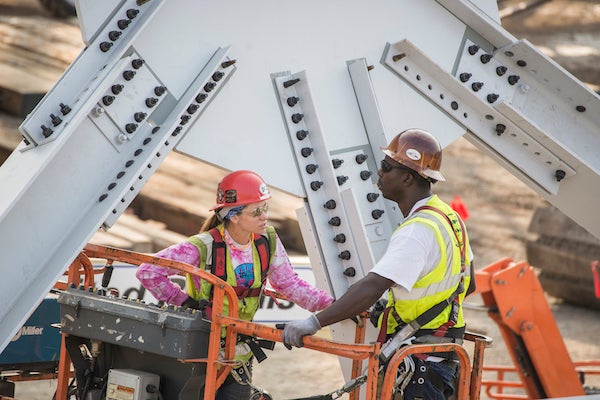Large racial and gender wage gaps remain in the U.S., the Pew Research Center reported last year. The American dream of a better tomorrow—with greater earnings and equal opportunity—is fraying for disadvantaged minorities and women. But it is not beyond repair. The construction industry has the potential to change the lives of those who need it most, providing living wage jobs that can support families and build wealth.

Many women and minority workers are not aware of the employment opportunities in the construction industry, which offers high-paying jobs and established apprenticeship programs. That must change. Image courtesy of Mortenson.
Today, the numbers on poverty and employment for American women, issued in Maria Shriver’s Women In America report, paint a sobering picture: women account for one in three, or 42 million, of those who live in, or on, the brink of poverty, and nearly two-thirds of all minimum wage workers. And since the Great Recession, median wealth for all minorities has fallen 9 percent compared to only 1 percent for non-Hispanic whites, notes Pew Research Center.
Companies are taking steps to address this issue with higher minimum wages. For instance, last year Walmart gave its entry-level workers an increase to $10 an hour, Ikea jumped its hourly to $12 and JP Morgan Chase & Co. bumped its minimum wage to $10.15. But that’s still well below the living wage level of $15 an hour or more that Fusion cites as a minimum for lifting workers out of poverty.

The Companies that Care AIM High program familiarizes minority high school students with the construction industry. Image courtesy of Power Construction.
These are issues that we can, and should, fix as a nation, and in our individual industries.
We believe the construction industry is an ideal place to start since it has the financial strength to boost wages, and lifestyles, for this group of struggling Americans—regardless of their zip code or educational background.
Examples prove the point. The average annual income for union first year apprentice operating engineers in the Chicago market, a craft worker job that requires on-the-job training or vocational school, was $110,000 last year according to our records. It will increase by about 4% this year. The potential for construction professionals on the management side is equally or even more attractive. In fact, earning power in the construction industry has improved dramatically since the Great Recession.
Yet despite these opportunities, the employment rate for women and minorities in construction remains low. In 2016, only 9.1 percent of workers in the construction industry were women, despite the fact that its gender pay gap is significantly lower (93.4 percent) than that of all U.S. industries (82.1 percent), according to National Association of Women in Construction statistics. Part of the problem is that few disadvantaged women and non-Hispanic minorities are aware of the opportunities the construction industry offers.

It will take proactive outreach, recruiting and apprenticeship programs—such as this internship program with the University of Chicago—to involve more women and minorities in the construction industry. Image courtesy of Mortenson.
Fixing this starts with proactive outreach, recruiting and apprenticeship programs, strategies we champion at Power Construction and Mortenson.
The Power of Outreach Programs
One of the biggest advantages of outreach programs that involve disadvantaged high school and college students is that they enable us to inspire women and minorities before their career direction is clear. Experience has shown us that giving these youth and young adults real world job experience on projects that are in close proximity to their communities shows them the difference they can make first hand, and has a profound impact on the choices they make in the future.
Both our companies have established paid summer internships to expose high school and college students to the construction industry, and participate in the highly effective Architects, Contractors and Engineers (ACE) Mentor Program. This national organization was founded in 1994 to recruit students from public high schools, with special efforts to reach women and minorities, and its programs teach students the ins-and-outs of the construction industry through hands-on education, even bringing them on project sites. As committed and active ACE participants, both of our companies have seen many of the youth we mentor go into the construction industry. Some have even joined our teams after college graduation.
The Power of Recruiting Programs
Recruiting programs are equally important to increasing the numbers of minorities and women in the construction industry. Through our Community Workforce Program at Mortenson, we reach out to minorities and women through community based organizations to assist in recruitment; offer these candidates hands on industry experience and support them in their unique needs as they seek employment and training in our field.
At Power, we partner with Communities Empowered Through Construction (CEC), an organization that mirrors our commitment to strengthen local communities, drive economic growth and create construction jobs. On top of the ongoing database of prescreened Chicago residents, the CEC also hosts minority contractor meet-and-greets to engender a pool of qualified construction candidates and minority contractors that are ready to work when needed.
CEC is extremely valuable in a city like Chicago where nearly half of all African American men ages 20-24 are unemployed and not attending school, reported the New York Times, and Illinois, which has the highest unemployment rate for African Americans in the U.S., according to a recent report from the Economic Policy Institute.
The Power of Apprenticeships
While a college degree is the prevalent path to high-paying jobs in most fields, formal apprenticeships are common in the construction industry. They evolved from the centuries-old craft guild tradition, but today’s unions that represent carpenters, plumbers, electricians, welders, sheet metal workers and more offer formal apprenticeship programs that are a blend of on-the-job training and formal instruction. With good wages and excellent benefits, they can be an ideal career path for minorities and women to enter high-paying trades, as noted by the U.S. Department of Labor.
These apprenticeship programs are a development tool for the construction industry, and as such we devote substantial time working with local unions and organizations such as CEC and Chicago Women in Trades to further and support their programs. We use our training programs to make potential candidates aware of the possibilities apprenticeships hold for their career path. And our team members often help minorities and women candidates who hope to enter apprenticeship programs prepare for their interviews and more.
The Power of Support for MWBEs
Outreach programs, recruiting efforts, internships and apprenticeships are effective, but only go so far. Beyond training and employment, minorities and women must be supported by the construction industry in their jobs—whether they are working for an established company or have started their own business.
Both of these scenarios pose different needs, but in both situations support is critical to success for minorities and women. We believe in rigorous mentorship programs, and in our own companies have embraced strategies to fulfill this mandate. We pair minorities and women with mentors in-house and pay it forward to our MWBE partners—literally and figuratively—with partnerships on projects and retention reduction programs to ease cash flow challenges and more.
Rebuilding the American dream for disadvantaged minorities and women that may have given up on that dream requires commitment from industries as a whole. The construction industry, with its proven track record of high earning power for workers of all races, genders and ages, has come far, but our work in this arena is far from done. We are tackling this challenge through outreach efforts, internships, apprenticeships and support programs that can—and should—move participation by minorities and women in the right direction. And it is time for industries to share successful strategies that will make the job easier for all of us.
